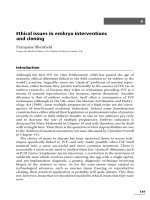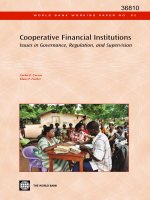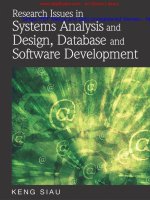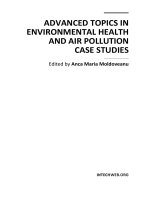FM11 Ch 28 Advanced Issues in Cash Management and Inventory Control
Bạn đang xem bản rút gọn của tài liệu. Xem và tải ngay bản đầy đủ của tài liệu tại đây (78.2 KB, 31 trang )
28 - 1
CHAPTER 28
Advanced Issues in Cash Management
and Inventory Control
Setting the target cash balance
EOQ model
Baumol Model
28 - 2
Theoretical models such as the Baumol
model have been developed for use in
setting target cash balances. The Baumol
model is similar to the EOQ model, which
will be discussed later.
Today, companies strive for zero cash
balances and use borrowings or
marketable securities as a reserve.
Monte Carlo simulation can be helpful in
setting the target cash balance.
Setting the Target Cash Balance
28 - 3
Insufficient inventories can lead to lost
sales.
Excess inventories means higher costs
than necessary.
Large inventories, but wrong items leads
to both high costs and lost sales.
Inventory management is more closely
related to operations than to finance.
Why is inventory management vital to
the financial health of most firms?
28 - 4
All values are known with certainty and constant
over time.
Inventory usage is uniform over time.
Carrying costs change proportionally with
changes in inventory levels.
All ordering costs are fixed.
These assumptions do not hold in the “real world,”
so safety stocks are held.
Assumptions of the EOQ Model
28 - 5
Total Total
TIC = carrying + ordering = CP(Q/2) + F(S/Q).
costs costs
C = Annual carrying costs (% of inv.).
P = Purchase price per unit.
Q = Number of units per order.
F = Fixed costs per order.
S = Annual usage in units.
Total Inventory Costs (TIC)
28 - 6
Derive the EOQ model from the total
cost equation
= - = 0
Q
2
=
EOQ = Q* = .
2FS
CP
√
d(TIC)
dQ
CP
2
FS
Q
2
2FS
CP
28 - 7
Inventory Model Graph
TIC
Carrying
Cost
Ordering Cost
0 EOQ Units
$
Average inventory = EOQ/2.
28 - 8
Assume the Following Data:
P = $200.
F = $1,000.
S = 5,000.
C = 0.2.
Minimum order size = 250.
28 - 9
What is the EOQ?
EOQ =
=
= 250,000 = 500 units.
2($1,000)(5,000)
0.2($200)
√
$10,000,000
40
√
√
28 - 10
TIC = CP( )+ F( )
= (0.2)($200)(500/2) + $1,000(5,000/500)
= $40(250) + $1,000(10)
= $10,000 + $10,000 = $20,000.
What are total inventory costs when
the EOQ is ordered?
Q
2
S
Q
28 - 11
Additional Notes
Average inventory = EOQ/2 = 500/2
= 250 units.
# of orders per year = S/EOQ
= $5,000/500 = 10.
At EOQ level, total carrying costs = total
ordering costs.
28 - 12
400 units:
TIC = CP(Q/2) + F(S/Q)
= 0.2($200)(400/2) + $1,000(5,000/400)
= $8,000 + $12,500 = $20,500.
Added cost = $20,500 - $20,000 = $500.
What is the added cost if the firm
orders 400 units or 600 units at a time
rather than the EOQ?
28 - 13
600 units:
TIC = CP(Q/2) + F(S/Q)
= 0.2($200)(600/2) + $1,000(5,000/600)
= $12,000 +$8,333 = $20,333.
Added cost = $20,333 - $20,000 = $333.
28 - 14
At any quantity ≠ EOQ, total inventory
costs are higher than necessary.
The added cost of not ordering the EOQ is
not large if the quantity ordered is close to
EOQ.
If Q < EOQ, then total carrying costs
decrease, but ordering costs increase.
If Q > EOQ, total carrying costs increase,
but ordering costs decrease.
Notes about EOQ
28 - 15
Weekly usage rate = 5,000/52
= 96 units.
If order lead time = 2 weeks, firm must
reorder when:
Inventory level = 2(96) = 192 units.
Suppose delivery takes 2 weeks.
Assuming certainty in delivery and
usage, at what inventory level should
the firm reorder?
28 - 16
Without safety stocks, the firm’s total
inventory costs = $20,000.
Cost of carrying additional 200 units
= CP(Safety stock)
= 0.2($200)(200) = $8,000.
Total inventory costs = $20,000 + $8,000
= $28,000.
Assume a 200-unit safety stock is
carried. What effect would this have
on total inventory costs?
28 - 17
Alternatively:
Average inventory = (500/2) + 200
= 450 units.
TIC = CP(Avg. Inv.) + F(S/Q)
= 0.2($200)(450) + $1,000(5,000/500)
= $18,000 + $10,000
= $28,000.
28 - 18
Reorder point = 200 + 192 = 392 units.
The firm’s normal 96 unit usage
could rise to 392/2 = 196 units per
week.
Or the firm could operate for 392/96
= 4 weeks while awaiting delivery of
an order.
What is the new reorder point with the
safety stock?
28 - 19
Discount affects operating inventory only.
Discount price = $200(0.99) = $198.
TIC = CP(Q/2) + F(S/Q)
= 0.2($198)(1,000/2) + $1,000(5,000/1,000)
= $19,800 + $5,000 = $24,800.
Suppose the firm could receive a
discount of 1% on orders of 1,000
or more. Should the firm take the
discount?
(More )
28 - 20
Savings = 0.01($200)(5,000) = $10,000
Added costs = $24,800 - $20,000 = $ 4,800
Net savings = $10,000 - $4,800 = $ 5,200
Firm should take the discount.
28 - 21
Yes, but it must be applied to shorter
periods during which usage is
approximately constant.
Can the EOQ be used if there are
seasonal variations?
28 - 22
How would the following factors affect
an EOQ analysis?
Just-in-time system: Eliminates the need
for using EOQ.
Use of air freight for deliveries: Reduces
the need for safety stock.
Computerized inventory control system:
Reduces safety stocks.
Flexibility designed plants: Reduces
inventory holdings of final goods.
28 - 23
The Baumol Model
The EOQ model can be applied to cash
management if you view cash as an
operating assets, just like inventory.
In this view, cash has a carrying cost,
which is the opportunity cost for investing
the funds, and an order cost, which is the
cost per transaction of liquidating
marketable securities and transferring the
money to a checking account.
28 - 24
C = cash raised each time by selling
securities or borrowing
r = opportunity cost of holding cash—
equal to the rate of return on marketable
securities or cost of borrowing
T = total amount of cash needed for
transactions during the year
F = fixed per transaction cost of selling
securities or obtaining a loan
28 - 25
Costs of cash—Holding costs
Holding cost
= (average cash balance)
x (opportunity cost rate)
Average cash balance = C/2
Holding cost = C/2 x r = rC/2









